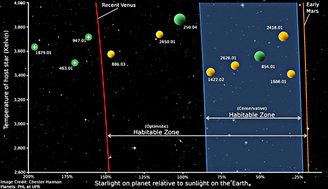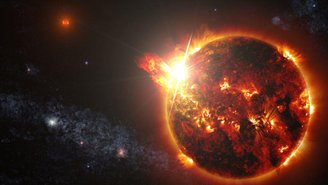Astronomers discover new super-Earth that could be habitable

Recent research, published in the journal Monthly Notices of the Royal Astronomical Society, reports the discovery of a super-Earth ripe for investigation, orbiting a red dwarf star “just” 137 light-years away from Earth. Called TOI-715b, the planet is about 1.55 the radius of ours and is within the star's habitable zone.
Within the same system, a second planet the same size as Earth was also observed, which, if confirmed, would be the smallest habitable zone that NASA's Transiting Exoplanet Survey Satellite (TESS) has found so far.
Habitable zone, explains the study, is a hypothetical “circumstellar region where an Earth-like planet could support liquid water on its surface”. In the case of the new planet, the concept is applicable, because, although it has a narrow orbit of just 19 days, its star TOI-715 is a medium red dwarf that has a much weaker luminosity than our Sun.
A new era in the discovery of exoplanets in habitable zones
 Conservative limits of habitable zones around cool, low-mass stars. Source: Pennsylvania State University
Conservative limits of habitable zones around cool, low-mass stars. Source: Pennsylvania State University
According to the paper, the era of detailed exoplanet atmospheric characterization recently deployed by the James Webb Space Telescope (JWST) is allowing astronomers to begin writing a new chapter in understanding these planets that orbit stars outside our solar system.
The new tools on board the JWST allow not only the detection of these distant worlds, but also to uncover some of their particularities, such as the composition of their atmospheres. This is essential for obtaining signs indicating the presence of life.
Furthermore, the very rudimentary concept of “habitable zone” was refined, starting in 2014, to that of conservative habitable zone (CHZ). The definition refers to a given star, in which its planet receives a level between 0.42 and 0.842 of solar exposure as Earth.
New super-Earth and its star are hope for habitable planets
 Red dwarf emitting a powerful solar flare.Source: NASA/Goddard Space Flight Center
Red dwarf emitting a powerful solar flare.Source: NASA/Goddard Space Flight Center
A little older than our Sun, at around 6.6 billion years old, the system comprised by TOI-715 and its super-Earth may represent, according to the authors, the best bet for discovering habitable planets.
Because they are smaller and cooler, red dwarfs allow their planets to clump together and remain in the CHZ. This orbital proximity causes its “shadows” to cross the face of its star more frequently and become more easily observable in space telescopes.
For further study, the planet TOI-715b is waiting for JWST to use its effective spectroscopy on water worlds. If the results support the habitability thesis, a better understanding of the radius and density gap of these exoplanets will be possible.
Stay up to date with the latest astronomy discoveries here at TecMundo. If you wish, visit one of the largest planets in the universe.





